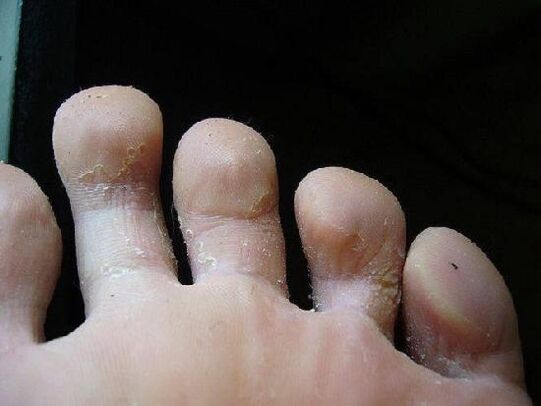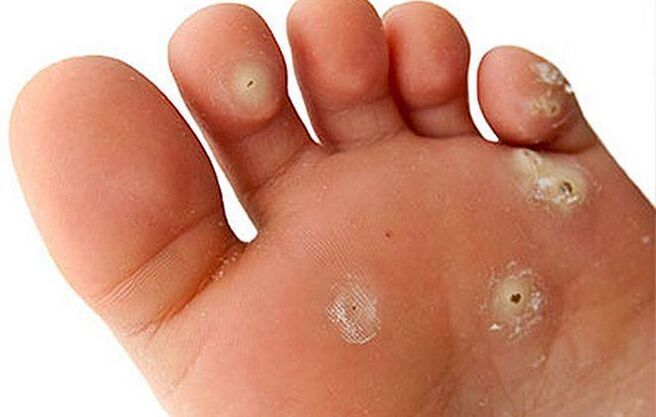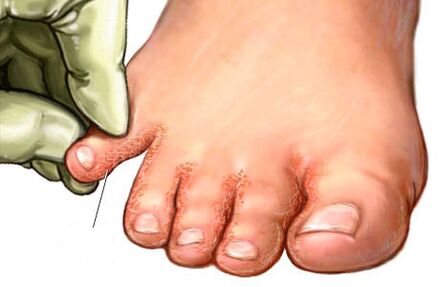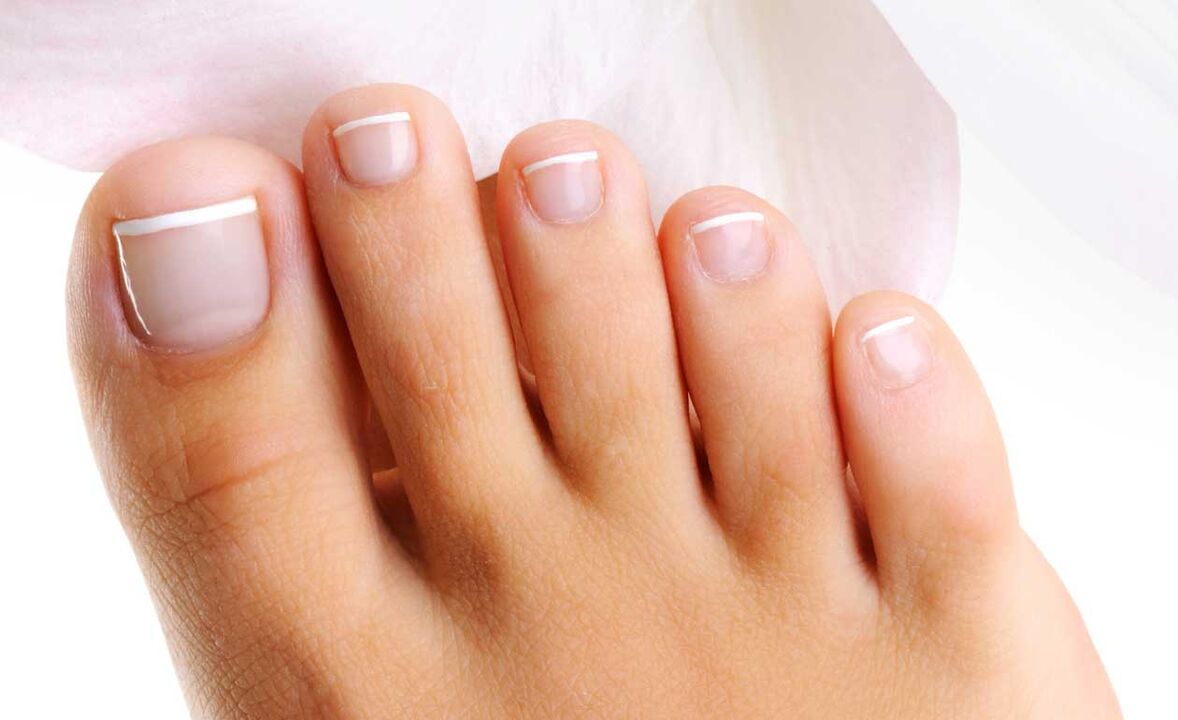Foot fungus is a seasonal disease and most often manifests itself during the season of wearing indoor shoes. Fungal infections of the feet do not attract as much attention as other fungi, such as nail fungus. This is because the foot is not visible unless you look at it specifically. First, strong manifestations are attributed to everyday causes.
The easiest way to test yourself for foot fungus is to smell your shoes! Bad odor is a sign of a fungal infection. Although the mushrooms themselves do not emit an odor, they are a waste. . . In addition, they are waste products of microorganisms located in the wounds caused by a fungal disease. And these are mainly staphylococci. When all this is taken together, it gives off an unpleasant odor on shoes and feet.
Combing the skin in the affected area causes the spread of infection!
The feet sweat a lot when they are in warm, closed shoes for a long time. Fungi that are not normally activated once begin to actively grow in an ideal environment for themselves. Thus, the second name of this disease appeared - "Athlete's foot". It is caused by fungal diseases of the feet and several types of fungi. Athletes suffer most from this mycosis because they spend most of their time in tight, closed shoes.
Athlete's foot is very common. However, a fungal infection can occur on the soles of the feet or on the skin between the toes.
Such mycoses can be caused by the appearance on the foot of one of the types of parasitic colonies of a contagious and highly contagious disease called foot fungus.
The nature of fungal diseases that cause extensive skin lesions is triggered by various types of fungi found in the study of analyzes.

How the fungus manifests itself
On the skin of the legs, the pathology first manifests itself in small areas that are prone to peeling, then the stain spreads with uneven edges, and the mycosis becomes more pronounced.
Symptoms of the fungus on the legs can be both lightning fast and slow. Because it all depends on how strong a person's immunity is and the type of microorganism that causes the disease.
The types of foot fungus are very different and manifest themselves, but if a person has any pathological changes in the feet, you should learn the cause from specialists. Mycologists will explain what a fungus is and teach you how to deal with it.
What does a foot fungus look like?
Toenail fungus is often accompanied by "athlete's foot" - it looks like a patchy skin that is noticeable. As the pathology spreads, the skin turns red and the changes become more noticeable. In addition, foot disease resembles large areas of dry skin with large flakes, sometimes with symptoms on one side and sometimes on both sides of the foot. The localization of the foot fungus is usually located in the lower part of the limbs, and the appearance of the joint depends on the degree of pathology.
The following types of differences are considered:
- a very dense layer of corneum at the base;
- begins to peel honey with flakes;
- the skin becomes inflamed;
- Damage to the feet is similar to bubbles.
The fungus that forms on the legs looks very expressive, so a person should see special manifestations and consult a doctor.

Causes of foot fungus
What to do if a mushroom appears? To begin, it is worth finding the reasons for the appearance and thinking about exactly where the spores can be taken and why the body does not respond properly.
Mycologists say that how an athlete's foot begins to form before the pathogenic flora develops: If a person uses the socks or shoes of an infected person, fungus can develop on the soles of the feet. do not wear slippers in places where people pass, ie in public baths, saunas and swimming pools, because there is the most suitable soil for the bacterial front.
How to identify the fungus on the feet
The development of mycoses is highly stimulated by a fungal disease, and such manifestations develop especially in the presence of chronic diseases. Foot diseases can be diagnosed independently, but it is worth carefully assessing the condition of the covering and how the skin looks under the toe, so as not to confuse any abrasion of the skin with signs of fungus on the foot.
The fungus of the legs is very diverse in terms of symptoms, because the types of fungi in the legs are not limited to one year, and each has its own manifestation.

What does a mushroom look like on its feet?
What the skin fungus on the legs looks like will determine what kind it is. Thus, the mycelium will leave the "calling card" when it arrives.
Sometimes people with such a pathological history do not know this, they just see a very dry coating on their feet, but they show that it should be so.
The general symptoms generally look like this:
- appearance of micro-cracks;
- slight itching, especially between the toes;
- heavy peeling;
- swelling and pain, sometimes at the sites of erosion;
- rarely, but bleeding occurs.
- deep cracks may appear.
How to treat athlete's foot
Treatment of the fungus in the foot is a long one, but if the preparatory stage is carried out correctly, that is, if at the time of diagnosis it is known which pathogen is parasitized in the body, therapy can be faster.
It is necessary to thoroughly treat the skin fungus using drugs derived from both internal and external medical pharmacological agents.
The athlete's foot is treated by carefully studying all the affected areas, which should be facilitated by a course of treatment.
You should consult a mycologist about how to treat the fungus. They will be able to talk in detail about which drugs can fight the disease well.
The treatment of foot disease can be divided into several parts. An important priority is to strengthen the most sensitive areas and restore the affected areas. It is important to know that the feet should always be dry and clean:
- and shoes should also be made of breathable materials;
- socks that can be replaced with cotton should be a good absorbent that collects moisture;
- After the feet are in the shoes all day, they should be rinsed thoroughly and lubricated with a special tool prescribed by a doctor.
It is also good to use special powders that help dry your feet.
The next part of treatment involves the use of antifungal drugs, for example:
- special ointments;
- a cream with a lighter texture than an ointment, with a deeper penetration angle inside;
- aerosols that penetrate the most difficult places for the smallest particles to enter.
Although almost all pharmacological drugs intended for the removal of pathogens are sold in a retail pharmacy network without a special prescription, the advice of an experienced specialist is not only already, but also a complex effect on the disease.
The most common reasons why treatment does not work are, first of all, an uncomfortable treatment regimen and irregular use of funds.
There are also the following reasons:
- many patients do not understand the severity of the disease and do not accept the proposed treatment;
- about a third of patients do not seek professional help at all and occasionally use self-medication that does not bring relief for obvious reasons;
- many patients do not believe that an accurate diagnosis of a particular pathogen is necessary;
- Many stop treatment themselves as soon as the first positive results are obtained.
How to treat foot fungus folk remedies
You can also treat athlete's foot with home remedies.
There is a good tool, you can do it yourself.
Ointment that completely destroys the mycosis of the feet:
- vinegar itself - 110 grams;
- a raw egg;
- butter - 200 grams (it is better to take a natural cultivator).
Scrub with absorbent substances on the kitchen shelf:
- soda;
- drunk coffee;
- ground oats;
- rice flour.
Such foam components can be an excellent helper when sanding the skin of the feet. Great for exfoliating skin particles and freeing unwanted areas from areas that need treatment.
Compressed with anesthetic solution.
A gauze compress is soaked in an anesthetic solution and strengthened on the foot at night. In the morning the bandage is removed and the affected areas are treated with a decoction of chamomile. Repeat for 7 days.
If you study the subject well, then foot diseases can be treated with folk remedies, and the skin fungus on the legs will pass without a trace, without the possibility of recurrence.

Consequences of mycosis developed on the skin of the legs
Treatment of skin fungus on the legs should be comprehensive and timely, otherwise the following complications can occur:
- products remaining after the parasitic elements themselves and vital activities increase the risk of allergies in patients;
- the course of dermatitis may be complicated by the formation of eczema and psoriasis;
- As the skin is severely injured, the infection penetrates the lower layers of the epidermis unimpeded and stimulates the onset of lymphostasis.
Warts on the athlete's foot appear more often and hyperkeratosis can occur.
Preventive measures
It prevents the formation of foot fungus, or rather.
First, it is possible to use ointments and folk remedies as additional protection, then the treatment of the fungus, although it occurs, will be carried out according to a simplified scheme.
You also need to perform the following steps:
- eat as prescribed by a healthy lifestyle;
- follow hygiene procedures;
- strengthen the body's immune defenses;
- take preventive measures.





























